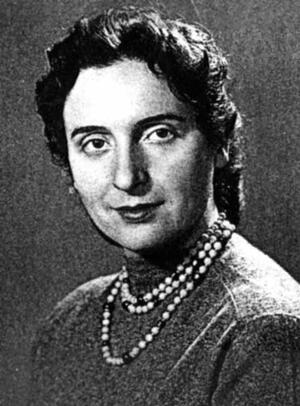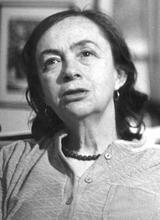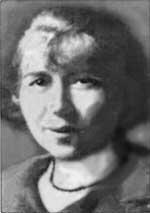Chava Rosenfarb
The work of twentieth-century Yiddish novelist Chava Rosenfarb has received great acclaim in the Yiddish literary world but, reflecting the fate of much recent Yiddish writing, has gone virtually unnoticed by the rest of the reading public.
Courtesy of the book, Found Treasures © 1994 by Frieda Forman et al.
Article
Chava Rosenfarb, a major Yiddish novelist of the second half of the twentieth century, is one of the few Holocaust survivors who transmuted their experiences into fiction rather than memoirs or reminiscences. Chava Rosenfarb was born on February 9, 1923 and her sister Henia (Rosenfarb) Reinhartz was born in 1927 in Lodz, Poland. Her father, Abraham Rosenfarb (1897–1945), was a restaurant waiter, and her mother Sima (née Pinczewska, ?1899–1959), worked in a textile factory. Rosenfarb’s parents were Bundists and she attended a secular Yiddish elementary school and a private Jewish high school, where the language of instruction was Polish. By the time she graduated in 1941, Rosenfarb, her family and the rest of the city’s Jewish population had been incarcerated in the Lodz ghetto by the Germans.
It was here that Rosenfarb began to write poetry. Through her poetry she made the acquaintance of Simkha-Bunim Shayevitsch (1907–1944), the great ghetto poet and author of the epic poem Lekh-Lekho (MS found in trash of liquidated Lodz ghetto after the war and published in 1946). She became his protegée and it was he who introduced her to the writers’ group of the ghetto, who quickly recognized her talent and accepted her, at age seventeen, as their youngest member.
When the ghetto was liquidated in August 1944, Rosenfarb and her family were transported to Auschwitz where, like her mother and sister, she survived the selection. They were sent to a labor camp at Sasel, near Hamburg, where they rebuilt houses for the bombed-out Germans of Hamburg. Rosenfarb continued to write poetry, which she memorized and later included in Di balade fun nekhtikn vald (The ballad of yesterday’s forest), her first published collection of poems, which appeared in London in 1947.
From Sasel, Rosenfarb, her mother and sister were sent to Bergen Belsen, where she was liberated by the British army in 1945. Soon after, she learned that her father had died in the last transport out of Dachau. In 1945, Rosenfarb, together with her mother and sister, crossed the border illegally into Belgium, where she lived as a Displaced Person until her marriage in 1949 to Henry Morgentaler (b. 1923), another Holocaust survivor. The couple immigrated to Montreal, Canada in 1950, and it was there that Rosenfarb did most of her writing. She had two children, Goldie and Abraham (b. 1956) with Henry Morgentaler, who earned his medical degree in 1956 and was subsequently instrumental in changing the Canadian abortion laws. The couple divorced in 1977. In 1998, Rosenfarb moved to Toronto, and in 2003 to Lethbridge, Alberta where she now resides.
Rosenfarb was profoundly affected by her experiences during the Holocaust, and her prodigious output of poetry, novels, short stories, plays and essays all deal with this topic in one way or another. She began as a poet, following the publication of Di balade fun nekhtikn vald with a book-length poem about her father, Dos lid fun yidishn kelner Abram (The song of the Jewish waiter Abram). She then published two more poetry collections, Geto un andere lieder (Ghetto and other poems), and Aroys fun gan-eydn (Out of Paradise). Rosenfarb’s play Der foigl fun geto (The bird of the ghetto), about the martyrdom of the Vilna partisan leader Yitzhak Wittenberg (1907–1943), was translated into Hebrew and performed by Israel’s Habimah Theater in 1966.
Finding that neither poetry nor drama could adequately express her feelings about the Holocaust, Rosenfarb turned to fiction. In 1972, she published Der boim fun lebn (The tree of life). This monumental three-volume epic, which has been translated into Hebrew and English, chronicles the destruction of the Jewish community of Lodz during World War II. The book, which was from the first hailed as a masterpiece won its author the Manger Prize for Yiddish literature in 1979.
The Tree of Life follows the fates of ten Jewish inhabitants of Lodz from before the outbreak of the war in 1939 until the ghetto’s liquidation in late summer 1944. Because these ten characters come from all walks of life, the novel recreates an entire Jewish ghetto community—and then unflinchingly chronicles its destruction. While most of Rosenfarb’s characters are fictitious, some are based on actual people. The most important of these is Mordechai Chaim Rumkowski (1877–1944), the chairman of the Judenrat (Jewish Council) in the Lodz ghetto. Rosenfarb describes the ironic road that Rumkowski traveled from being the founder and director of an orphanage before the war, to being the Nazi-appointed puppet leader of the ghetto.
Rosenfarb followed The Tree of Life with Bociany, published in Yiddish in 1982. Translated into English by the author, it was published in two volumes by Syracuse University Press. The translation won Rosenfarb the John Glassco Prize for Literary Translation in September 2000. Bociany is a prequel to The Tree of Life, giving the early history of some of the characters who appear in that novel.
Rosenfarb had always been reluctant to write about the horrors of the concentration camp in her fiction. It was not until 1992 that she finally felt capable of attempting such a description in her novel Briv tsu Abrashen (Letters to Abrasha), which contains searing descriptions of the death camps and their horrors.
Rosenfarb was a frequent contributor of essays to the Yiddish literary journal Di goldene keyt (The Golden Chain), where in the early 1980s she also began to publish a series of short stories about the lives of Holocaust survivors in Canada. The best known of these stories, “Edgia’s Revenge,” (published in English in Found Treasures: Stories by Yiddish Women Writers, 1994) describes the unhealthy symbiotic relationship of two women survivors who meet again in Montreal after the war.
Rosenfarb’s important essay on the problems of being a Yiddish woman writer appeared in English in Gender and Text in Modern Hebrew and Yiddish Literature (1993). She has contributed essays and reviews to the Montreal Gazette, as well as to numerous Yiddish-language publications. She is the winner of numerous international literary awards, including Israel’s prestigious Manger Prize for Yiddish Literature. In 2001, she was the subject of a two-part documentary on the Canadian Broadcasting Corporation’s radio program “Ideas.”
Despite the great acclaim that her writing has received in the Yiddish-speaking world, Rosenfarb’s work is little known by the non-Yiddish reading public. Her fate as a writer thus reflects the general isolation of Yiddish literature from the mainstream of world literature, an isolation that has unfortunately grown more profound with time.
Briv tsu abrashen (Letters to Abrasha) (Yiddish). Tel Aviv: 1992; Excerpted in English translation in the Montreal Gazette, May 7, 1995.
Bociany
(English). Translated by the author. Syracuse: 2000; Of
Lodz and Love. (English). Translated by the author. Syracuse: 2000.
These two volumes earned the author the John Glassco Prize for Literary Translation
for 2000.
Botshani. Two vols. (Yiddish). Tel Aviv: 1983; Serialized in Yiddish in the Jewish Daily Forward, 1982. Excerpted in Canadian Jewish Anthology, edited by Jacob Zipper. Montreal: 1982.
Der boym fun lebn (The Tree of Life). 3 vols. (Yiddish). Tel Aviv: 1972.
Ets Hakhayim (The tree of life). 3 vols. (Hebrew). Translated by Shloyme Shenhod. Tel Aviv: 1978.
The Tree of Life (English). Trans. the author in collaboration with Goldie Morgentaler. Melbourne: 1985; Excerpts have appeared in Pakn-Treger 25 (Summer 1997): 66–83; Midstream 31, 4 (April 1985): 14–18, and in Canadian Yiddish Writing, edited by A. Boyarsky and L. Sarna, 23–48. Montreal: 1976;
The Tree of Life: A Trilogy of Life in the Lodz Ghetto. Book I: On the Brink of the Precipice, 1939. In English. Trans. the author in collaboration with Goldie Morgentaler. Madison, WI: 2004.
Survivors: Seven Short Stories. Trans. Goldie Morgentaler. Toronto: 2004.
SHORT FICTION
Briv tsu got (Letters to God). (Yiddish). Di goldene keyt 140 (1995): 51–72.
Edgia’s Revenge. (English). Translated by Goldie Morgentaler. In Found Treasures: Stories by Yiddish Women Writers. Edited by Frieda Forman et al. Toronto: 1994.
“François.” (Yiddish). Di goldene keyt 135 (1993): 16–47.
A Friday in the Life of Sarah Zonabend. In Contemporary Jewish Writing in Canada. Translated by Goldie Morgentaler. Edited Michael Greenstein. Lincoln, Nebraska: 2004.
The Greenhorn. In Not Quite Mainstream: Canadian Jewish Short Stories. Translated by Goldie Morgentaler. Edited by Norman Ravvin. Calgary and Montreal: 2001.
The Greenhorn. (English). Canadian Jewish Short Stories. Translated and edited by Miriam Waddington, 111–122. Toronto: 1990.
In serengeti. (Yiddish). Di goldene keyt 128 (1990): 115–156.
Letste liebe (Last love). (Yiddish). Di goldene keyt 110–111 (1983): 117–140.
Royt feigele (Red birdie). (Yiddish). Di goldene keyt 139 (1994): 86–98.
POETRY COLLECTIONS
Aroys fun gan-eydn (Out of Paradise) (Yiddish). Tel Aviv: 1965.
Di balade fun nekhtikn vald (The ballad of yesterday’s forest) (Yiddish). London: 1947. This was republished a year later as Di balade fun nekhtikn vald un andere lider (The ballad of yesterday’s forest and other poems), in conjunction with Fragmentn fun a tog-bukh (Fragments of a diary) Montreal: 1948.
Dos lid fun dem yidishn kelner Abram (The song of the Jewish waiter Abram) (Yiddish). London: 1948.
Geto un andere lider (Ghetto and other poems). (Yiddish) Montreal: 1950.
MEMOIRS AND ESSAYS
“Bergen-Belsen Diary” (Yiddish). Montreal: 1948. Excerpted in Kiddush Hashem, edited by S. Niger. New York: 1948: 775–779.
“Laterna Magica: Prague Travelogue.” (Yiddish). Di goldene keyt 137 (1993): 119–137.
“Feminism and Yiddish Literature: A Personal Approach.” Gender and Text in Modern Hebrew and Yiddish Literature, edited by Naomi B. Sokoloff et al. New York. 1992.
“Isaac Bashevis and Sholem Asch.” (Yiddish). Di goldene keyt 133 (1992): 75–104.
“My Debut.” (English). Midstream 35:3 (April 1989): 26–29.
“Paul Celan and His Colleagues.” (Yiddish). Di goldene keyt 138 (1994): 53–70.
“Writing in a Language Foreign to Nearly All.” Book Section. The Montreal Gazette. Aug. 14, 1999.
Yiddish Poets in Canada (Pamphlet). Mississauga: 1994.
PLAYS
Der foigl fun geto (The Ghetto Bird) (Yiddish). Montreal: 1958; Staged in Hebrew translation by Habimah, Tel Aviv, 1966.
SELECTED SECONDARY SOURCES
Abley, Mark. Spoken Here: Travels Among Threatened Languages. Toronto: 2003.
Cooper, Judy. “Chava Rosenfarb’s The Tree of Life.” Broadcast on Radio Australia, May 26, 1989.
Duhl, Lisa. Rocking an Empty Cradle: A Psychological Study of Yiddish Holocaust Lullabies: Isaiah Spiegel, Chava Rosenfarb. Unpublished diss., California School of Professional Psychology. UC Berkeley, 1999.
Elberg, Yehuda. “Chava Rosenfarb.” Undzer vort. Paris: 1974.
Emiot, Israel. “A Great Book about Lodz.” Jewish Daily Forward, New York, July 29, 1972.
Jonasovitch, Isaac. “The Tree of Life.” (Yiddish). Folk un Medine. Tel Aviv (Summer 1975).
Kahan, Isaac. Di Zukunft. New York (October 1973).
Lev, Yacov. “Chava Rosenfarb’s Trilogy, The Tree of Life” (Yiddish). Undzer Shtimme. Paris, (June 1973).
Mlotek, Yossl. “Editorial: The Tree of Life” (Yiddish). Kultur un lebn. New York (May–June 1973).
Morgentaler, Goldie. “Land of the Postscript: Canada and the Post-Holocaust Fiction of Chava Rosenfarb.” Judaism 49:2 (Spring 2000): 168–183.
Naves, Elaine Kalman. “Chava Rosenfarb’s The Tree of Life,” a two-part documentary on Ideas, Canadian Broadcasting Corporation, Radio 1. February 6 and 13, 2001; Rebroadcast Oct. 10 and 17, 2001.
Ibid. “Chava Rosenfarb.” Putting Down Roots: Montreal’s Immigrant Writers. Montreal: Véhicule, 1998.
Rak, Meyer. “Chava Rosenfarb and her great trilogy about the Holocaust” (Yiddish). Kultur un lebn. New York (August–September 1973).
Ravvin, Norman. “Ghost Writing: Chava Rosenfarb’s The Tree of Life.” A House of Words Montreal: 1997.
Sharlett, Jeffrey. “More Objective than Tears: A Profile of Chava Rosenfarb.” Pakn Treger 25 (Summer 1997): 50–65.
Yanovsky, Joel. “Standard-bearer for Yiddish: For Chava Rosenfarb, writing in her native tongue is a ‘sacred duty.’” Book Section. The Montreal Gazette. Saturday, April 1, 2000.
PRIZES AND AWARDS
John Glassco Prize of the Literary Translation Association of Canada. Ottawa, Ontario, Canada: September 2000. Awarded for translation into English of Bociany and Of Lodz and Love.
Award of the American Association of Professors of Yiddish. MLA Conference, Toronto, Canada, 1998.
I. J. Segal Prize, Montreal, Canada: 1972 and 1993.
Congress for Jewish Culture Prize, New York, USA: 1993 and 1988.
Sholem Aleichem Prize, Tel Aviv, Israel, 1990.
Rosenfeld Prize, Toronto, Canada, 1990.
Atran Prize, New York, 1985.
Manger Prize, Tel Aviv, Israel, 1979.
Niger Prize, Buenos Aires, Argentina, 1972.






